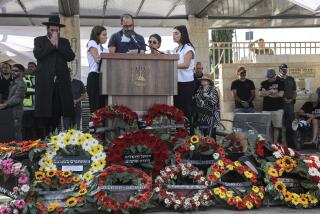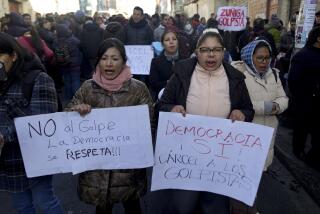Frustration Mounts as Stalemate Continues
- Share via
LIMA, Peru — As diplomats and security experts from the United States, Japan and other nations converged here Thursday to help resolve the hostage standoff at the Japanese ambassador’s residence, leftist guerrillas released four more of their hundreds of captives.
Still, there was growing anxiety among diplomats of the two dozen nations that have citizens being held hostage by the Tupac Amaru Revolutionary Movement about the lack of communication by the Peruvian government regarding the negotiations.
“All of our diplomatic colleagues feel a sense of frustration that we are not getting more information from the government about what they are doing and how they are doing it,” a Western diplomat said.
The government’s almost total official silence on the crisis results from the secretive, sometimes authoritarian style of President Alberto Fujimori, who relies on a handful of close advisors, according to political analysts and diplomats.
“It is a very personal style,” commentator Fernando Rospigliosi said. “Nobody says anything. Nobody has shown their face in this crisis. He is not accustomed to negotiating.”
Foreign Minister Francisco Tudela, whom Rospigliosi called one of the best negotiators in the Fujimori administration, is one of the many prominent political figures among the hostages who were seized Tuesday night at a celebration of the birthday of the Japanese emperor.
While there was a broadcast report that Fujimori has written President Clinton, assuring him that the hostages’ safety is his top priority, Peruvian officials have had no comment about published stories that deals are being considered to ease the crisis by releasing some guerrillas from Peruvian prisons in a partial amnesty.
In the letter to Clinton released Thursday evening, Fujimori said his principal objective is “safeguarding . . . the health and life of those who are inside.”
The negotiations Thursday were being led by Peru’s education minister through the mediation of the Canadian ambassador, who was released by the guerrillas Wednesday, and a Red Cross official.
The talks produced results at 6:02 p.m., when the barricaded guerrillas allowed four men to leave the fortress-like compound in the wealthy San Isidro district.
The freed hostages were identified as the chairman of Nissan Co. in Peru, who left in a wheelchair, a Red Cross official and two elderly Peruvians of Japanese descent.
After spending half an hour in the ambassador’s residence talking to the guerrillas and hostages, Anthony Vincent, the Canadian ambassador, said: “The discussions were cordial. The hostages were in good condition. People are behaving magnificently. There has not been a single incident.”
Meanwhile, security and anti-terrorism experts from a variety of U.S. agencies arrived in Lima. Their ostensible mission is to review security at the U.S. Embassy.
“We have sent some security experts to assist the ambassador because of his concern about the security situation,” Secretary of State Warren Christopher told reporters in Washington.
Glyn Davies, State Department spokesman, said the group will be available to help Peruvian authorities deal with the hostage situation if requested.
Davies said the U.S. Embassy in Lima was working to inform the estimated 10,000 Americans living in Peru of the terrorist attack and advise them to take greater security precautions than normal.
“The message is to take an extra degree of caution and tell them what areas and streets to avoid,” he said.
The FBI is also working with the National Security Council, U.S. marshals and other agencies on the crisis, Atty. Gen. Janet Reno said.
Despite widely published reports here that six U.S. diplomats are among the hostages, American officials Thursday stuck to their policy of declining to confirm or deny the presence of U.S. citizens in the captured compound.
The Japanese foreign minister and a delegation also landed in Lima on Thursday to consult with Fujimori on the crisis.
The Japanese are expected to play a pivotal role because, technically, the incident is occurring on their soil and because of their economic and cultural presence in Peru. There are an estimated 50,000 Peruvians of Japanese descent.
Special teams of diplomats and security advisors have been dispatched by many of the other Asian, Latin American and European nations embroiled in the crisis.
The guerrillas have threatened to kill the hostages if the government does not meet a list of demands, including the release of hundreds of imprisoned terrorists and safe passage to a remote jungle valley.
As agitated Peruvians followed every development of 24-hour televised coverage of the standoff, Red Cross officials and diplomatic sources revised their estimate of the number of hostages. Previous reports put the figure at 490, but the Red Cross gave a new estimate of 380; other figures range up to 450.
There were also new, conflicting reports about how the terrorists invaded the residence despite the presence in the street outside of a police SWAT team, Japanese security guards and scores of bodyguards accompanying dignitaries to the gala reception.
Peruvian newspapers reported Thursday that members of the Tupac Amaru Revolutionary Movement, or MRTA, rented a house next to the walled ambassador’s residence three months ago and that some of them made their entry from that property. One released hostage said she saw gunmen draped in red-and-white MRTA flags dropping into the garden over the wall after explosives were detonated, a diplomatic source said Thursday.
But diplomats and others also believe that some of the guerrillas infiltrated the residence among waiters and deliverymen, while others arrived in a phony ambulance.
The Peruvian government has said nothing about the method of the attackers, an estimated 15 to 25 guerrillas who reportedly include three women.
Although the Peruvian government and foreign diplomats alike had described terrorism as a thing of the past, in recent months there were sporadic bombings and other indications of an upsurge in political violence. During recent weeks, the security forces pressed the hunt for the fugitive leaders of Sendero Luminoso (Shining Path), Peru’s largest rebel movement, and announced the capture of a high-ranking Sendero Luminoso commander.
Ironically, high-ranking Peruvian police officials in charge of anti-terrorist operations are among the hostages.
On Thursday afternoon, some observers said they heard gunshots from inside the compound. But there was no confirmation, and the shots may have been a signal that the hostages would be released: The guerrillas said to radio interviewers by phone that they would fire shots before making public statements.
In the streets around the compound, troops and police riding in armored personnel carriers were a frequent sight Thursday, and a blackout of uncertain provenance left houses in the area without electricity. Like many mansions in Lima, the ambassador’s residence has its own generator.
Otherwise, the scene at the besieged residence was calmer Thursday. There were no further telephoned threats from the Tupac leaders to local radio and television stations. The guerrillas permitted a steady flow of Red Cross workers to bring carts of food, water, clothes, toilet paper, fans and other items to the front steps of the residence.
“Everything is calm inside,” said Red Cross official Michel Minnig after he made one visit bearing supplies. The lanky, balding Minnig has become one of the familiar images of the drama as he trudges in and out of the the police cordon around the compound.
After more than 48 hours in captivity, the hostages were said to be in good shape. They reportedly have been divided by nationality and distributed among the rooms of the residence.
There is continuing speculation here that there will be further releases simply because of the logistical difficulty of guarding, feeding and caring for hundreds of captives.
After speaking to released spouses of several Latin American diplomats being held captive, Colombian Ambassador Luis Guillermo Grillo said: “The situation is very uncomfortable, there are too many people. No matter how comfortable a house may be, it can’t hold so many people.”
Times staff writer Tyler Marshall in Washington contributed to this report.
More to Read
Sign up for Essential California
The most important California stories and recommendations in your inbox every morning.
You may occasionally receive promotional content from the Los Angeles Times.













